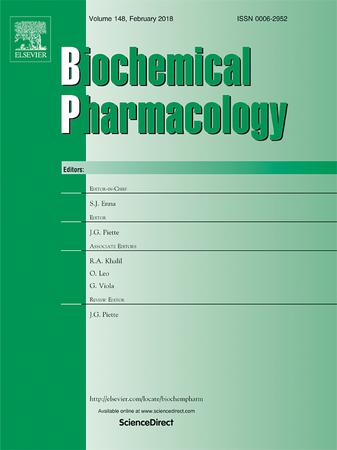xCT/Slc7a11通过破坏AMPKα抑制mTOR激活促进肺动脉高压
IF 5.3
2区 医学
Q1 PHARMACOLOGY & PHARMACY
引用次数: 0
摘要
虽然mTOR在肺动脉高压(PAH)的发展中起着关键作用,但其抑制因子AMPKα起着抑制剂的作用。虽然mtor驱动的质膜交换器和氨基酸转运体xCT(由Slc7a11基因编码)的转录上调对细胞增殖和肿瘤发生至关重要,但xCT在PAH中的作用仍未被探索。在本研究中,我们发现缺氧处理的人肺动脉内皮细胞(HPAECs)、缺氧暴露小鼠和Sugen5416/缺氧(SuHx)诱导的PAH小鼠的肺中xCT表达升高。敲除xCT可阻止suhx条件小鼠PAH和右心衰的发展。xCT抑制剂磺胺吡啶可预防和逆转suhx诱导的小鼠PAH。在PAH和HPAECs小鼠肺中,删除和抑制xCT激活AMPKα并灭活mTOR。柳氮磺胺吡啶通过激活hpaec中的AMPKα抑制mTOR。mTOR抑制剂雷帕霉素在HPAECs中降低xCT表达,激活AMPKα,抑制mTOR。这些发现表明,xCT可能通过抑制AMPKα和激活mTOR来促进PAH的发展。现有药物如磺胺氮嗪、西罗莫司和二甲双胍阻断xCT和mTOR或激活AMPKα可能为PAH的治疗提供了方便的策略。本文章由计算机程序翻译,如有差异,请以英文原文为准。

xCT/Slc7a11 promotes pulmonary arterial hypertension by disrupting AMPKα suppression of mTOR activation
While mTOR plays a key role in the development of pulmonary arterial hypertension (PAH), its suppressor, AMPKα, acts as an inhibitor. Although mTOR-driven transcriptional upregulation of the plasma membrane exchanger and amino acid transporter xCT, encoded by the Slc7a11 gene, is critical for cell proliferation and tumorigenesis, the involvement of xCT in PAH remains unexplored. In this study, we found that xCT expression was elevated in hypoxia-treated human pulmonary arterial endothelial cells (HPAECs) and the lungs of hypoxia-exposed mice and Sugen5416/hypoxia (SuHx)-induced PAH mice. Knockout of xCT prevented the development of PAH and right heart failure in SuHx-conditioned mice. The xCT inhibitor sulfasalazine prevented and reversed SuHx-induced PAH in mice. Deleting and inhibiting xCT activated AMPKα and inactivated mTOR in mouse lungs with PAH and in HPAECs. Sulfasalazine suppressed mTOR through activation of AMPKα in HPAECs. The mTOR inhibitor rapamycin reduced xCT expression, activated AMPKα, and suppressed mTOR in HPAECs. These findings suggest that xCT promotes the development of PAH, likely through suppression of AMPKα and activation of mTOR. Blockage of xCT and mTOR or activation of AMPKα by existing drugs such as sulfasalazine, sirolimus, and metformin may offer readily therapeutic strategies for PAH.
求助全文
通过发布文献求助,成功后即可免费获取论文全文。
去求助
来源期刊

Biochemical pharmacology
医学-药学
CiteScore
10.30
自引率
1.70%
发文量
420
审稿时长
17 days
期刊介绍:
Biochemical Pharmacology publishes original research findings, Commentaries and review articles related to the elucidation of cellular and tissue function(s) at the biochemical and molecular levels, the modification of cellular phenotype(s) by genetic, transcriptional/translational or drug/compound-induced modifications, as well as the pharmacodynamics and pharmacokinetics of xenobiotics and drugs, the latter including both small molecules and biologics.
The journal''s target audience includes scientists engaged in the identification and study of the mechanisms of action of xenobiotics, biologics and drugs and in the drug discovery and development process.
All areas of cellular biology and cellular, tissue/organ and whole animal pharmacology fall within the scope of the journal. Drug classes covered include anti-infectives, anti-inflammatory agents, chemotherapeutics, cardiovascular, endocrinological, immunological, metabolic, neurological and psychiatric drugs, as well as research on drug metabolism and kinetics. While medicinal chemistry is a topic of complimentary interest, manuscripts in this area must contain sufficient biological data to characterize pharmacologically the compounds reported. Submissions describing work focused predominately on chemical synthesis and molecular modeling will not be considered for review.
While particular emphasis is placed on reporting the results of molecular and biochemical studies, research involving the use of tissue and animal models of human pathophysiology and toxicology is of interest to the extent that it helps define drug mechanisms of action, safety and efficacy.
 求助内容:
求助内容: 应助结果提醒方式:
应助结果提醒方式:


